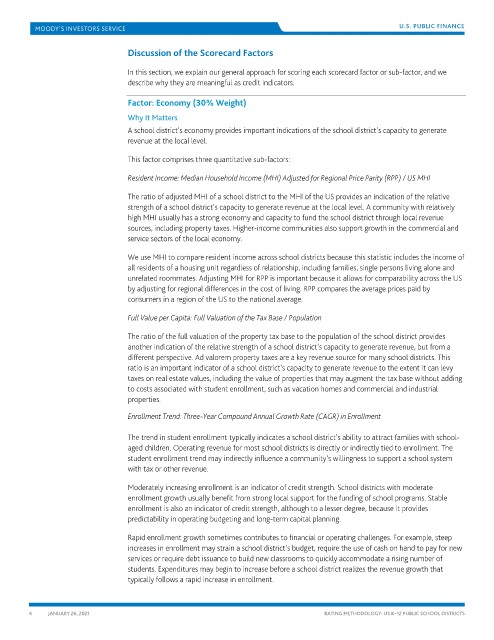Page 1638 - draft
P. 1638
U.S. PUBLIC FINANCE
Discussion of the Scorecard Factors
In this section, we explain our general approach for scoring each scorecard factor or sub-factor, and we
describe why they are meaningful as credit indicators.
Factor: Economy (30% Weight)
Why It Matters
A school district’s economy provides important indications of the school district’s capacity to generate
revenue at the local level.
This factor comprises three quantitative sub-factors:
Resident Income: Median Household Income (MHI) Adjusted for Regional Price Parity (RPP) / US MHI
The ratio of adjusted MHI of a school district to the MHI of the US provides an indication of the relative
strength of a school district’s capacity to generate revenue at the local level. A community with relatively
high MHI usually has a strong economy and capacity to fund the school district through local revenue
sources, including property taxes. Higher-income communities also support growth in the commercial and
service sectors of the local economy.
We use MHI to compare resident income across school districts because this statistic includes the income of
all residents of a housing unit regardless of relationship, including families, single persons living alone and
unrelated roommates. Adjusting MHI for RPP is important because it allows for comparability across the US
by adjusting for regional differences in the cost of living. RPP compares the average prices paid by
consumers in a region of the US to the national average.
Full Value per Capita: Full Valuation of the Tax Base / Population
The ratio of the full valuation of the property tax base to the population of the school district provides
another indication of the relative strength of a school district’s capacity to generate revenue, but from a
different perspective. Ad valorem property taxes are a key revenue source for many school districts. This
ratio is an important indicator of a school district’s capacity to generate revenue to the extent it can levy
taxes on real estate values, including the value of properties that may augment the tax base without adding
to costs associated with student enrollment, such as vacation homes and commercial and industrial
properties.
Enrollment Trend: Three-Year Compound Annual Growth Rate (CAGR) in Enrollment
The trend in student enrollment typically indicates a school district’s ability to attract families with school-
aged children. Operating revenue for most school districts is directly or indirectly tied to enrollment. The
student enrollment trend may indirectly influence a community’s willingness to support a school system
with tax or other revenue.
Moderately increasing enrollment is an indicator of credit strength. School districts with moderate
enrollment growth usually benefit from strong local support for the funding of school programs. Stable
enrollment is also an indicator of credit strength, although to a lesser degree, because it provides
predictability in operating budgeting and long-term capital planning.
Rapid enrollment growth sometimes contributes to financial or operating challenges. For example, steep
increases in enrollment may strain a school district’s budget, require the use of cash on hand to pay for new
services or require debt issuance to build new classrooms to quickly accommodate a rising number of
students. Expenditures may begin to increase before a school district realizes the revenue growth that
typically follows a rapid increase in enrollment.
4 JANUARY 26, 2021 RATING METHODOLOGY: US K–12 PUBLIC SCHOOL DISTRICTS

